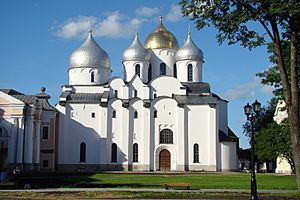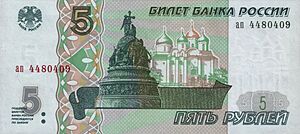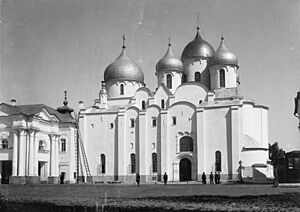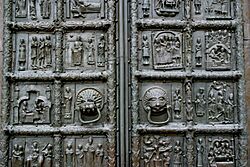Cathedral of Saint Sophia, Novgorod facts for kids
Quick facts for kids Cathedral of Saint SophiaСофийский собор |
|
|---|---|

View of the cathedral from the southeast
|
|
| Religion | |
| Affiliation | Russian Orthodox |
| Province | Diocese of Novgorod and Staraya Russa |
| Year consecrated | 1050 or 1052 |
| Location | |
| Location | Veliky Novgorod, Russia |
| Architecture | |
| Architectural type | Church |
| Groundbreaking | 1045 |
| Completed | 1050 |
| Specifications | |
| Height (max) | 38 metres (125 ft) |
| Dome(s) | 5 |
| Official name: Historic Monuments of Novgorod and Surroundings | |
| Type | Cultural |
| Criteria | ii, iv, vi |
| Designated | 1992 (16th session) |
| Reference no. | 604 |
| State Party | Russia |
| Region | Eastern Europe |
The Cathedral of Saint Sophia, the Holy Wisdom of God in Veliky Novgorod, Russia, is a very old and important church. It is the main church for the Novgorod region and is sometimes called the "mother church." Its full name, "Holy Wisdom of God," comes from the Greek word sophia, meaning wisdom. This refers to Christ, not a female saint named Sophia.
Contents
History of the Cathedral
Building the Ancient Church
This amazing stone cathedral is 38 meters (about 125 feet) tall. It has five domes and was built between 1045 and 1050. Prince Vladimir of Novgorod and Bishop Luka Zhidiata oversaw its construction. It replaced an older wooden church from the late 900s. This makes it one of the oldest church buildings in Russia. It is also the oldest building of any kind in the country that is still in use today. Bishop Luka Zhidiata officially opened the cathedral on September 14, either in 1050 or 1052.
Changes Over Time
The main dome, which is golden, was covered in gold by Archbishop Ioann in 1408. There is a sixth, larger dome that sits on top of a tower. This tower leads to upper areas called galleries. In olden times, people believed the Novgorodian treasury was kept here. There was also a large library, which was said to have been started by Yaroslav the Wise. In 1859, this library moved and had over 1,500 books, some from the 1200s! Today, the current archbishop has started a new library there, which has about 5,000 books. A Sunday school is also held in the gallery.
The domes probably got their special helmet-like shape around the 1150s after a fire. The inside of the church was painted in 1108. Later, in the 1860s and 1890s, parts of the interior were repainted. A white stone belltower was built by Archbishop Evfimy II. He was a great supporter of architecture. He also had the Palace of Facets built nearby in 1433. The clocktower was also built under his care, but it fell down and was rebuilt in 1673.
Symbol of Novgorod
From the 1100s to the 1400s, the cathedral was the most important religious and ceremonial place in the Novgorod Republic. This republic was a huge area that stretched from the Baltic Sea to the Ural Mountains. The cathedral became a symbol of the city itself. People in Novgorod would say they were willing "to lay down their heads for Holy Wisdom." They even said, "Where Holy Wisdom is, there is Novgorod."
The "House of Holy Wisdom" was a very large landowner in the Novgorod area. The bishop, who later became an archbishop, was in charge of this "House."
Burial Place of Important People
The cathedral has been a burial place for many important people in Novgorod's history. Forty-seven famous individuals are buried here. These include princes, city leaders, and 32 bishops, archbishops, and metropolitans. Prince Vladimir was the first to be buried here in 1052. Most burials are under the floor in special porches on the sides of the cathedral. Today, some burials are in the main part of the church. For example, Bishop Nikita lies in a glass-covered tomb. On his feast days, his tomb is opened so people can honor him.

Challenges and Restoration
The cathedral was looted by Ivan the Terrible in the 1570s. However, Archbishop Leonid restored it. He also built the Tsar's Pew, a special seat inside the church.
During the Nazi occupation of Novgorod in World War II, the area around the cathedral was badly damaged. But the cathedral itself survived. The large cross on the main dome has a metal bird attached to it, which might represent the Holy Spirit as a dove. This cross was taken by Spanish soldiers during the war. For over 60 years, it was kept in a museum in Madrid, Spain. On November 16, 2004, it was finally returned to the Russian Orthodox Church.
The domes were heavily damaged in the war. A large painting of Christ inside the main dome was ruined. There is a legend that the painters painted Christ with a clenched fist. The archbishop asked them to repaint it with an open hand. But the next morning, the hand was miraculously clenched again. A voice from the dome supposedly told the archbishop to leave the painting alone. The voice said that as long as Christ's fist remained closed, he would hold the fate of Novgorod in his hand.
During the Soviet era, the cathedral was used as a museum. It was given back to the Russian Orthodox Church in 1991. An inscription inside the church shows that it was rededicated by Bishop Lev and Patriarch Alexius II.
Special Features
Novgorod's St. Sophia was one of the first churches in Slavic lands to look different from the usual Byzantine style. Its plain walls and narrow windows make it look more like Romanesque architecture from Western Europe than Greek churches of that time.
The Novgorod cathedral also looks very different from its famous namesake in Kyiv, Ukraine. One art historian said the Kyiv cathedral is like a bride, while the Novgorod cathedral is like a warrior. It has very little decoration, uses few bricks, and its design goes up vertically instead of spreading out horizontally. These features influenced other churches built in Novgorod later, like the Yuriev Monastery Cathedral and the Antoniev Monastery Cathedral.
Important Icons
The oldest icon in the cathedral is probably the Icon of the Mother of God of the Sign. Legend says this icon miraculously saved Novgorod in 1169 when enemies attacked the city. It was brought out and displayed in the cathedral and on the city walls. During the Soviet period, it was kept in a museum. In the early 1990s, the icon was returned to the cathedral. It now stands near the Golden Doors of the iconostasis (a screen covered with icons).
Another very old icon is the one of Sophia, the Holy Wisdom of God. This icon is also part of the iconostasis, usually where the icon of the church's patron saint hangs.
Famous Gates
Three famous sets of gates have been part of the cathedral over the centuries: the Korsun, Vasilii, and Sigtuna (or Płock, or Magdeburg) Gates.
- The Korsun Gates are at the western entrance to a small chapel. They are said to have been brought to Novgorod long ago.
- The Vasilii Gates were given to the cathedral in 1335. They were later taken by Tsar Ivan IV in 1570 and can still be seen near Moscow.
- The doors at the west entrance, called the Sigtuna, Magdeburg, or Płock Gates, are very special. They were most likely made by masters from Magdeburg in Germany around 1152–1154 for a cathedral in Płock, Poland. It's not exactly known how Novgorod got them, but they were probably a gift or acquired in the late 1400s. These gates are only opened a few times a year for special events. Since 1982, copies of these gates have been in the Cathedral in Płock.
The Pigeon Legend
A figure of a pigeon, which symbolizes the Holy Spirit, sits on top of the cross on the main dome of the cathedral. A local legend says that a real pigeon landed on the dome and froze in terror when it saw the Massacre of Novgorod. In the 1700s, the cathedral had a gold-plated silver pigeon in its treasury. The dome and the pigeon figure were damaged during World War II. They were restored after the war. The original pigeon figure was returned to Novgorod in 2005 by former soldiers who had fought there.
See also
- Saint Sophia Cathedral, Kyiv
- Saint Sophia Cathedral in Polotsk
- Hagia Sophia




